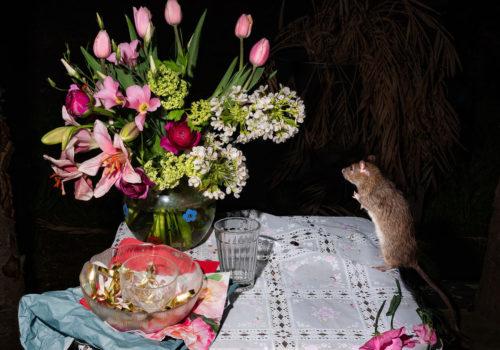A wonderful parallel world, so close to us when we know how to observe it: the new book by German photographer Lia Darjes tenderly tells of the sometimes unsuspected presence of our animal neighbors.
This book contains a series of still lifes that explore the intimate relationship between animals and everyday objects. These productions pay homage to the culinary art and to our furry and feathered friends, while drawing inspiration from the finesse of 16th century German realist painting, notably the works of Georg Flegel and Frans Snyders.
Lia Darjes’ compositions are imbued with delicate humor, cradled in a healthy innocence. In Plate V, a slug wanders in the darkness on the rim of a glass of orange juice, surrounded by other small creatures, giving the scene an absurd dimension. By playing on the strangeness of the moment and the familiarity of the chosen objects, Lia Darjes invites the viewer to rediscover the hidden beauty of these creatures to which we perhaps do not pay enough attention.
Each composition is carefully arranged: the objects, the colors, the patterns… All contribute to the singular aesthetic offered by Lia Darjes. In Plate XV, three small birds are seated on a flowered tablecloth. This frozen moment carries the memory of a country lunch, where humans gave way to feathered animals. The scene, bathed in tranquility, echoes classic paintings of rural life, while remaining deeply anchored in the present thanks to the careful choices of the staging. As here, where a bottle opener is casually placed on a freezer bag, throughout the photos, we can see plastic Tupperware boxes, butcher’s wrapping paper and paper plates; making these tables ours.
Here, there are no domestic animals, but wild creatures who relish their freedom, like that of inviting themselves to our table once dinner is finished. To create this series, the photographer invited her friends to dinner and, in a careful staging, left the table to the meanderings of the night. Her camera, mounted on a tripod and equipped with a trigger, was activated as soon as movement was felt: this is how these animals were caught in the act.
This contrast between the everyday and the fantastic is at the heart of Darjes’ work, which invites us to rethink our relationship with nature. It pushes us to see animals as more than just subjects for observation; but as life companions integrated into our daily universe. Birds, rodents and insects become the discreet but essential actors of a visual story where, through their absence, humanity is constantly suggested.
Noémie de Bellaigue
Plates I-XXXI by Lia Darjes is published by Chose Commune and was presented in Berlin as part of an exhibition at the Galerie Robert Morat.
















